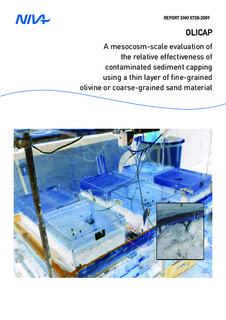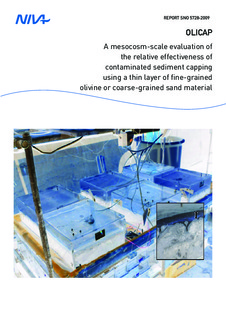| dc.contributor.author | Allan, I. | nb_NO |
| dc.contributor.author | Skei, J. | nb_NO |
| dc.contributor.author | Næs, K. | nb_NO |
| dc.contributor.other | Allan, I. - Project manager | nb_NO |
| dc.date.accessioned | 2014-08-01T10:52:54Z | |
| dc.date.available | 2014-08-01T10:52:54Z | |
| dc.date.issued | 2009 | nb_NO |
| dc.identifier | 5728 | nb_NO |
| dc.identifier.isbn | 978-82-577-5463-1 | nb_NO |
| dc.identifier.issn | 1894-7948 | nb_NO |
| dc.identifier.uri | http://hdl.handle.net/11250/214351 | |
| dc.description.abstract | Olivine mineral produced in large quantities by North Cape Minerals AS is a good candidate to be used as part of capping procedures for the remediation of contaminated marine sediments. Mesocosms experiments were undertaken to evaluate the relative effectiveness of olivine material as a capping material for the containment of selected sediment contaminants, compared with that obtained with natural sand. Two different contaminated sediments impacted by a range of contaminants were used in this study. The primary objective was to compare sediment-overlying water fluxes of contaminants out of these sediments prior to and following capping with thin layers of olivine or natural sand. Additionally, populations of a selected benthic organism, ragworm, were added prior to cap placement in order to provide natural bioturbators to the sediments. Following cap placement two series of measurements of pore water and whole-sediment Hg concentration-depth profiles were made. Both capping materials did not appear to impact on ragworm activity. This work demonstrates some differences between contaminant fluxes observed following capping of contaminated sediments with olivine versus capping with sand. However, in many cases, these differences are limited. Based on these results and for these particular experimental conditions, no clear advantage of using olivine compared with sand for purposes such as thin layer capping. Alternative experimental designs may be implemented in to corroborate these findings. It is likely that increasing the thickness of the cap will result in an increase in the efficiency of olivine to reduce contaminant fluxes when the aim is isolation capping. | nb_NO |
| dc.description.sponsorship | North Cape Minerals As | nb_NO |
| dc.publisher | Norsk institutt for vannforskning | nb_NO |
| dc.relation.ispartofseries | NIVA-rapport;5728 | nb_NO |
| dc.rights | Navngivelse-IkkeKommersiell-DelPåSammeVilkår 3.0 Norge | nb_NO |
| dc.rights.uri | http://creativecommons.org/licenses/by-nc-sa/3.0/no/ | nb_NO |
| dc.subject | marine contaminants | nb_NO |
| dc.title | OLICAP - A mesococm-scale evaluation of the relative effectiveness of contaminated sediment capping using a thin layer of fine-grained olivine or coarser-grained sand material | nb_NO |
| dc.type | Research report | nb_NO |
| dc.rights.holder | Norsk institutt for vannforskning/Norwegian institute for water research | nb_NO |
| dc.subject.nsi | VDP::Matematikk og naturvitenskap: 400 | nb_NO |
| dc.source.pagenumber | 45 | nb_NO |
| dc.subject.keyword | olivin | nb_NO |
| dc.subject.keyword | sedimentkappe | nb_NO |
| dc.subject.keyword | forurensede sedimenter | nb_NO |
| dc.subject.keyword | mesocosm | nb_NO |
| dc.subject.keyword | olivine | nb_NO |
| dc.subject.keyword | sediment capping | nb_NO |
| dc.subject.keyword | contaminated sediments | nb_NO |
| dc.subject.keyword | mesocosms | nb_NO |
| dc.relation.project | O-28150 | nb_NO |


